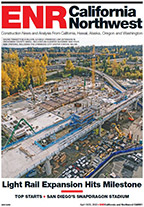Those challenges consist of ensuring that the airport’s daily operations continue uninterrupted, that work progresses without any incidents and that the project is completed within the set 24-month schedule, Jensen says.
“Imagine taking the Empire State Building and laying it out on its side and sticking it in the middle of traffic,” Jensen says. That is an example, he says, of what daily work on the project is like for the team, which includes a joint venture of architects Skidmore Owings & Merrill, New York, and Arup, New York.“We’re claiming a piece of land out there, creating choreography between building and operations; we’re constantly moving into different places.”
Delta is currently operating out of Terminals 2 and 3. When Terminal 4 is completed, Terminal 2 will be used for domestic flights and Terminal 3 will be demolished and turned into a site for aircraft parking. Phase 1B involves demolition and abatement work on Terminal 3 and is expected to be completed in 2015. Work for that phase is set to be bid out some time between June and October, he says.
The projects are part of Delta’s $2-billion plan to add new products and facilities companywide, says Joseph Perone, an airline spokesman. Delta is also building an international terminal at the Hartsfield-Jackson Atlanta International Airport. That terminal is scheduled to open this spring. And, in New York, Delta is about to start renovating the U.S. Airways’ terminal at LaGuardia Airport; Delta recently acquired U.S. Airway’s landing rights at the airport. That is expected to be a $100-million project, and construction is set to begin this March.
—Carolina Worrell
A Power Cable Runs Through It
When completed in 2013, an eight-mile-long power cable running from a Ridgefield, N.J., converter station into midtown Manhattan will provide New York Power Authority customers with access to more diverse sources of power, including renewable energy and natural gas. The plan has been hailed by officials on both sides of the Hudson as a way to provide lower electricity costs, improve reliability and create jobs. Even so, the project took six years to wind its way through the approval process of federal, state and local government authorities and to finally begin construction last May.
“This has been in the works and under development for a while,” says Christopher Hocker, vice president of planning at Fairfield, Conn.-based Powerbridge, which established the project’s owner Hudson Transmission Partners. But the scope of the work—an $850-million, 660-MW underground transmission line that runs four miles under the Hudson River—had to be carefully vetted by numerous regulators and stakeholders before it could be signed off on, he says.
“From our perspective, the project was able to be a go-ahead now because of the importance at this point of bringing power into New York,” says Patrick Reager, senior vice president of Joseph Jingoli & Son, Lawrenceville, N.J., which has a separate contract for site preparation at the Ridgefield converter station. The city is expected to eventually run into a power shortage as the energy load increases, he says.
The project will also include significant upgrades and reinforcements to northern New Jersey’s transmission system as part of an agreement with PJM Interconnection, the region’s electric grid operator.
The power line begins in Ridgefield, where a new converter station is being built on an old industrial site, requiring the demolition of a 100,000-sq-ft warehouse, Reager says. Work included removing the underground concrete foundations of the warehouse to make way for the new piling installation, he says.
“We were [initially] contracted for 150 days for the entire site,” Reager says. But that schedule was later shortened to 120 days. “We brought the project in 30 days ahead of schedule for the owner,” he adds.
A joint venture of Germany’s Siemens Energy, Erlangen, and Italy’s Prysmian Power Cables & Systems, Milan, is the engineering, procurement and construction contractor on the job. Siemens’ technology and equipment is being used at the Ridgefield station to covert alternating current (AC) from the PJM Interconnection system to direct current, and then back to AC at the same site, Hocker says.
Burns & Roe, Oradell, N.J., is providing engineering and architecture services on the project, and Birdsall Services Group, Sea Girt, N.J., is the engineer for the land-based portion of the cable.
Prysmian is responsible for the design, supply and installation of the 345-kilovolt, high-voltage AC land and submarine line. In New Jersey, the power line will run about three miles from the converter station to the river in Edgewater.
The submarine cable, which will be buried a minimum of 10 ft below the Hudson’s bottom, traverses under the river for about four miles until it reaches Manhattan. Prysmian is using its cable-laying ship, the Giulio Verne, to install a bundle of three high-voltage submarine cables and two optical fiber data transmission cables under a portion of the river. The company says it will install this cable system using its own designed hydro-plow machine.
The transmission line will exit the river between Piers 92 and 94 in Manhattan and run beneath the West Side Highway. It will end up at Con Edison’s substation at West 49th Street.
—Esther D’Amico












Post a comment to this article
Report Abusive Comment